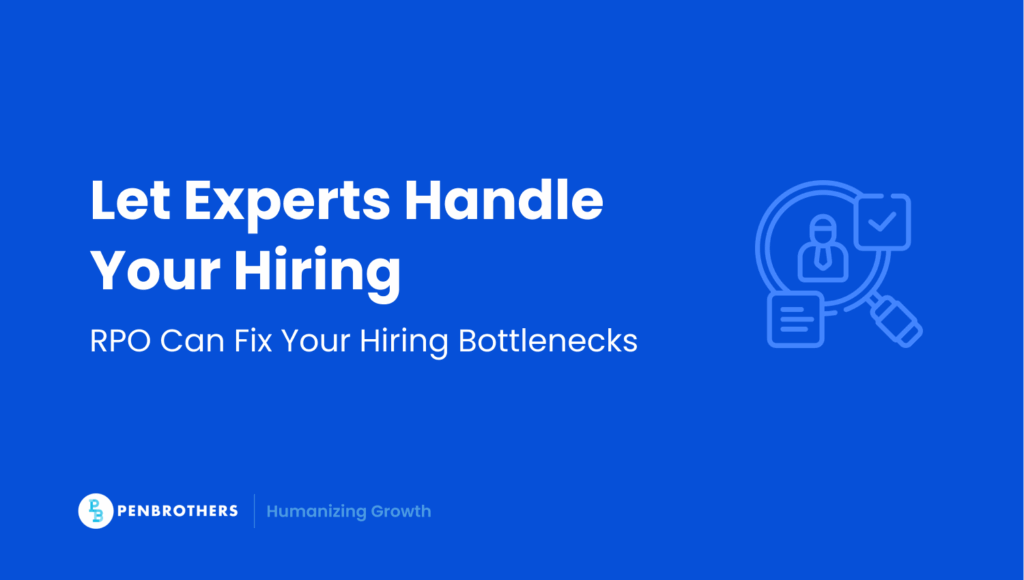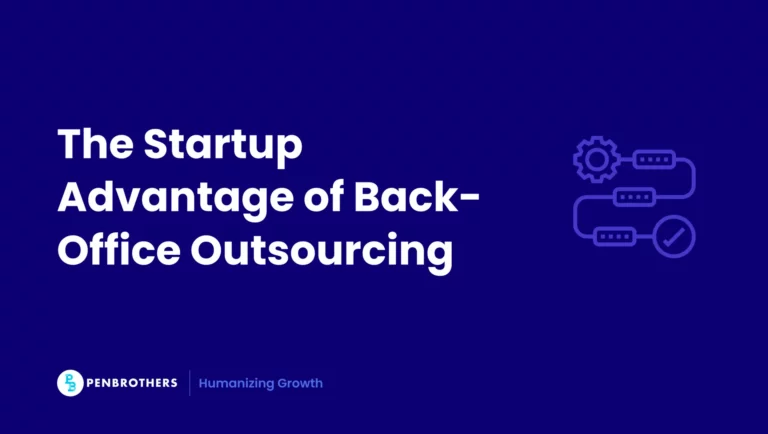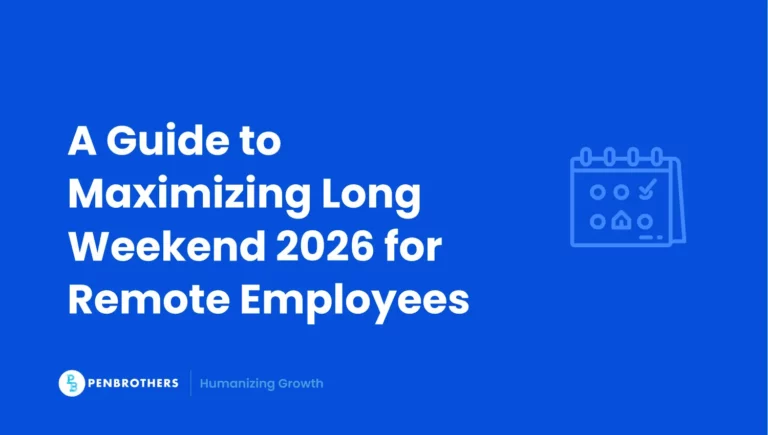You’ve scaled fast. The headcount’s lagging behind.
Your talent acquisition team is stretched thin, swamped with urgent requisitions, and fighting fires instead of building pipelines. You’ve tried job boards, agencies, and even internal referrals, but quality keeps slipping while time-to-fill balloons.
This is where recruitment process outsourcing (RPO) starts making sense, not as a stopgap but as a strategic lever.
RPO is more than plugging holes in your hiring process. It’s a full-stack recruitment engine. One that partners deeply with your team, aligns with your goals, and flexes with your hiring demands.
What Is RPO? (Recruitment Process Outsourcing)
RPO is a strategic partnership where a company delegates all or part of its recruitment activities to an external provider.
Unlike staffing agencies, RPO providers don’t just deliver resumes. They build and run recruitment infrastructure, integrating with your internal team, tools, and culture. RPO isn’t a vendor. It’s an extension of your talent acquisition function.
With RPO, you gain access to expert recruiters, recruitment tech, and data-driven hiring strategies tailored to your business needs.
According to The Business Research Company, the global Recruitment Process Outsourcing (RPO) market is projected to grow from $6.32 billion in 2023 to $7.37 billion in 2024, at a compound annual growth rate (CAGR) of 16.7%. This growth underscores the increasing demand for scalable, flexible hiring solutions across industries worldwide. Explore the latest outsourcing trends shaping global talent strategy.
Types of RPO Services (And Which One Fits You)
RPO isn’t a one-size-fits-all solution. Different organizations have different hiring goals, timelines, and internal capabilities. The right model depends on your unique context. Here are the four primary types:
End-to-End RPO
This model handles the full recruitment lifecycle from workforce planning to onboarding. It includes sourcing, screening, interviews, assessments, offer management, and compliance documentation. Providers often use recruitment tech stacks like ATS and CRM platforms to streamline the process.
Ideal for businesses undergoing rapid expansion or looking to completely rebuild their talent acquisition infrastructure. It ensures consistency, quality, and scalability while positively impacting your employer brand through professional candidate experiences.
Project RPO
Best for companies with urgent, high-volume, or time-bound hiring needs such as product launches, market expansions, or seasonal surges. The RPO partner supports a defined hiring project without locking you into a long-term contract.
Success depends on close collaboration. You define goals, timelines, and hiring criteria. The RPO team executes with precision and speed.
Selective RPO
If you only need help in specific parts of your recruitment funnel, this model fits. Selective RPO allows you to outsource tasks like talent sourcing, initial screening, or interview coordination while maintaining control over final interviews and hiring decisions.
It’s a flexible way to enhance efficiency without giving up strategic control, especially useful when internal teams are short on bandwidth or specialized expertise.
On-Demand RPO
This is the most flexible option. You engage RPO recruiters only when needed. No retainers. No long-term commitments. Just agile recruitment support that scales with your hiring spikes.
It’s particularly valuable for startups or companies navigating unpredictable growth. You get immediate access to expert recruiters who can jump in fast and deliver results.
On-demand RPO combines speed, flexibility, and specialization. It’s designed to help you respond to market conditions in real time without overburdening your in-house HR.
Key Benefits of RPO for Your Business
1. Reduced Time-to-Hire
RPO providers leverage optimized workflows, proactive sourcing, and automation to help you move fast without cutting corners. Top candidates are only on the market for an average of 10 days, making efficiency in hiring not just beneficial, but essential.
When internal delays pile up, great talent slips away. With RPO, your recruitment engine stays always-on and opportunity-ready.
2. Cost Efficiency
Filling roles faster is one cost advantage. Avoiding bad hires is another. The Society for Human Resource Management (SHRM) reports the average cost-per-hire at $4,700, but poor hires can cost three to four times that employee’s annual salary. RPO helps consolidate your recruitment tools, eliminate inefficiencies, and provide better hiring accuracy. RPO providers also understand compensation benchmarks and can negotiate smart, competitive offers that attract but don’t overspend.
3. Better Candidate
Quality More than resumes. RPO providers focus on identifying high-potential candidates who align with your company’s culture and long-term goals. They use behavioral assessments, structured interviews, and employer branding tactics to attract and evaluate better-fit talent. This leads to stronger hires, higher retention, and reduced churn within the first year.
4. Scalability
Your hiring needs are not static Your strategy shouldn’t be either. RPO adapts quickly to changing headcount demands, whether you’re hiring in bursts for product launches or slowing down during restructuring phases. No need to stretch internal HR thin or hire full-time recruiters you may not retain.
With RPO, you expand or contract your hiring capability without carrying unnecessary overhead. Learn how effective offshore teams are built to scale sustainably.
5. Industry Expertise
Access to seasoned recruiters with domain-specific knowledge is a game-changer. From tech roles in Southeast Asia to compliance-heavy positions in finance, RPO providers understand both local nuances and global expectations.
What makes this more relevant today is the global shift toward skills-based hiring.
According to Deloitte, organizations are increasingly moving away from rigid job titles and focusing instead on capabilities and competencies, allowing for faster, more agile hiring across functions and markets. This makes the ability to assess industry-specific skills even more critical.
At Penbrothers, we bring a hybrid approach: global recruitment experience combined with deep familiarity with local talent ecosystems.
What to Watch Out For: RPO Isn’t Perfect
Let’s be clear. RPO is not a cure-all. It’s not a plug-and-play solution for every company or situation. While the benefits are substantial, certain challenges can arise especially if the engagement isn’t well structured or aligned with your internal expectations.
Here are the common concerns businesses raise about RPO and how to address them head-on.
1. Perceived Loss of Control
Outsourcing recruitment can feel like handing over the keys to your employer brand. Some companies fear losing visibility into candidate pipelines or not having final say in who gets hired.
This usually happens when roles and responsibilities aren’t well defined. Without shared ownership, friction builds.
How to mitigate it:
- Set clear Service Level Agreements (SLAs) and recruitment KPIs.
- Use shared systems or dashboards to track progress in real time.
- Ensure your internal HR has a seat at the table during hiring decisions.
2. Cultural Misgalignment
A provider might be great at sourcing talent but do they understand your company’s DNA?
Misaligned values can result in candidates who are technically qualified but don’t gel with your team. This is especially risky for startups and high-growth companies where culture drives performance.
How to mitigate it:
- Evaluate cultural compatibility during vendor selection, not just credentials.
- Ask for case studies in similar industries or team dynamics.
- Share your internal brand guidelines and EVP (employer value proposition) early.
3. Communication Gaps
RPO works best as a partnership not a handoff. Poor communication between the internal team and the RPO provider can create delays, misaligned messaging, or inconsistent candidate experiences.
How to mitigate it:
- Assign a dedicated point of contact on both sides.
- Set regular check-ins and status reviews.
- Use collaborative tools like ATS dashboards, shared scorecards, and real-time candidate feedback loops.
4. Need for Ongoing Oversight
Outsourcing doesn’t eliminate accountability. To get the most from your RPO provider, you’ll need to invest in managing the relationship, aligning strategy, reviewing metrics, and continuously refining the approach.
How to mitigate it:
- Treat RPO as a strategic partnership, not a vendor transaction.
- Review performance data monthly or quarterly.
- Encourage feedback from hiring managers and candidates to fine-tune the process.
How to Choose the Right RPO Provider
Choosing an RPO partner isn’t just procurement. It’s a strategic move on par with hiring someone to lead a department. A great provider will operate like an extension of your team. A wrong fit will slow you down.
To get it right, go beyond cost comparisons. Focus on alignment, capability, and long-term value.
1. Clarify Your Goals
Don’t start with the provider. Start with your pain points.
Are you scaling across regions? Fixing inefficiencies in your funnel? Building a remote team in a new market?
Clearly define:
- The outcomes you want to achieve (e.g., shorter time-to-fill, better candidate retention)
- What “success” looks like in 6 and 12 months
- Whether you need end-to-end support or help with specific bottlenecks
This clarity will help you filter providers who offer more than generic promises.
2. Evaluate Capabilities, Not Just Credentials
Experience matters but context matters more. Ask questions that reveal how a provider works in environments like yours:
- Have they hired in your industry or target regions?
- What sourcing methods and tech stack do they use (e.g., ATS, AI-matching tools)?
- How do they measure performance and what benchmarks do they hold themselves to?
Look for signs of adaptability, not just scale. A smaller provider who understands your hiring DNA is more valuable than a large one who doesn’t.
3. Prioritize Cultural Fit
You’re trusting someone to represent your employer brand. That requires alignment, not only in values but also in how they treat candidates, hiring managers, and your internal team.
Test for culture fit by:
- Meeting the actual recruiters who’ll work on your account
- Observing how they communicate during the pitch process
- Asking how they ensure a consistent candidate experience across touchpoints
Red flags? Overpromising. Vague answers. Generic solutions.
4. Ask for Proof, Not Just a Pitch
Slide decks don’t build confidence, results do. Request case studies from companies in your sector or with similar hiring challenges. Ask:
- What KPIs were set at the start?
- How did they perform over time?
- What lessons were learned and what changed as a result?
Case studies reveal not just competence, but how the provider iterates and collaborates under pressure. Check out their success stories to get proof of their expertise.
5. Check for Operational Maturity
A good RPO provider knows how to plug in. Look for evidence that they can work with your systems, people, and priorities. Ask about:
- Implementation timelines and onboarding
- SLAs, escalation paths, and reporting cadence
- Data access, privacy compliance, and tech integration
If it feels like heavy lifting to get them up to speed and it probably will be.
Implementing RPO: What Success Looks Like
RPO only delivers value when the execution is tight. It’s not enough to sign a contract and expect results. Success comes from intentional alignment, seamless tech integration, and continuous optimization between your internal team and your RPO partner.
Think of implementation not as a handover but as a handshake.
Here’s what a successful RPO rollout should look like:
1. Co-Creation of Success Metrics
Start by defining what “good” looks like for your business. Whether it’s reducing your average time-to-hire, improving candidate quality, or lowering cost-per-hire, these KPIs should be agreed upon from day one. They anchor accountability and shape strategy.
Key actions:
- Co-create a performance dashboard with SLAs and KPIs
- Define hiring goals by department, geography, or business unit
- Establish mutual accountability: who owns what, by when?
2. Seamless Tech and ATS Integration
Visibility is everything. If your RPO provider is working in silos or using disconnected tools, you lose momentum and control. Integrating your Applicant Tracking System (ATS), recruitment marketing tools, and communication platforms ensures you both operate from the same source of truth.
Key actions:
- Sync systems (e.g., Greenhouse, Workable, BambooHR)
- Enable shared candidate pipelines and scorecards
- Align calendaring and scheduling tools for real-time collaboration
At Penbrothers, our recruiters embed directly into your stack. That means no tech barriers, no delays just full transparency from day one.
3. Embedded Collaboration
You don’t just need recruiters, you need partners. Weekly syncs, recruiter-hiring manager huddles, and structured feedback loops help surface what’s working and what’s not. The faster you can close the loop, the faster you can iterate.
Key actions:
- Hold weekly check-ins between your hiring team and RPO lead
- Review open roles, candidate quality, and blocker issues
- Create feedback cycles from
- candidates and hiring managers alike
4. Real-Time Reporting and Optimization
Great RPO isn’t set-and-forget. It’s evolve-and-refine. Data should guide every decision from where you source candidates to how you write job descriptions. A responsive RPO provider constantly analyzes your recruitment funnel and suggests improvements.
Key actions:
- Track funnel metrics weekly (e.g., number of candidates per stage)
- A/B test job posts and sourcing strategies
- Recalibrate based on seasonal hiring trends or role difficulty
5. Cultural and Operational Integration
An RPO team should feel like your own. From the tone of voice in candidate emails to how recruiters speak about your company values. Alignment drives candidate experience and employer brand perception.
At Penbrothers, we embed recruiters into your day-to-day operations. They work in your tools, align with your culture, and are held accountable like any internal hire.
Final Thoughts
RPO is no longer a last resort for overwhelmed HR teams. It’s a modern answer to a broken recruitment model.
When executed well, RPO unlocks faster hiring, stronger teams, and a more strategic HR function. It lets you focus on growing your business while the right talent finds you.
Thinking about outsourcing recruitment? Let’s talk. Penbrothers helps global companies build agile offshore teams without the complexity.






